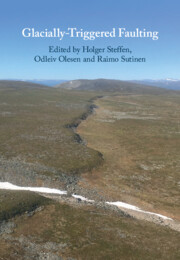Book contents
- Glacially-Triggered Faulting
- Glacially-Triggered Faulting
- Copyright page
- Contents
- Figures
- Tables
- Contributors
- Preface
- Part I Introduction
- Part II Methods and Techniques for Fault Identification and Dating
- Part III Glacially Triggered Faulting in the Fennoscandian Shield
- Part IV Glacially Triggered Faulting at the Edge and in the Periphery of the Fennoscandian Shield
- 15 Lateglacial and Postglacial Faulting in Denmark
- 16 Glacially Induced Faults in Germany
- 17 Glacially Induced Faulting in Poland
- 18 Soft-Sediment Deformation Structures in the Eastern Baltic Region
- Part V Glacially Triggered Faulting Outside Europe
- Part VI Modelling of Glacially Induced Faults and Stress
- Part VII Outlook
- Index
- References
15 - Lateglacial and Postglacial Faulting in Denmark
from Part IV - Glacially Triggered Faulting at the Edge and in the Periphery of the Fennoscandian Shield
Published online by Cambridge University Press: 02 December 2021
- Glacially-Triggered Faulting
- Glacially-Triggered Faulting
- Copyright page
- Contents
- Figures
- Tables
- Contributors
- Preface
- Part I Introduction
- Part II Methods and Techniques for Fault Identification and Dating
- Part III Glacially Triggered Faulting in the Fennoscandian Shield
- Part IV Glacially Triggered Faulting at the Edge and in the Periphery of the Fennoscandian Shield
- 15 Lateglacial and Postglacial Faulting in Denmark
- 16 Glacially Induced Faults in Germany
- 17 Glacially Induced Faulting in Poland
- 18 Soft-Sediment Deformation Structures in the Eastern Baltic Region
- Part V Glacially Triggered Faulting Outside Europe
- Part VI Modelling of Glacially Induced Faults and Stress
- Part VII Outlook
- Index
- References
Summary
The Danish area is divided by the Fennoscandian Border Zone into a north-eastern part, which is generally tectonically stable with low seismicity marginally related to well-known fault zones, and close to no seismicity in the south-western non-shield part. Stress measurements show that lithospheric plate motion is generally responsible for the modern stress pattern. However, stress changes induced by the weight-relief from the ice sheets during the Pleistocene appears to have created tectonic instability with maximum intensity at the time of deglaciation. The Danish area is generally covered by thick successions of unconsolidated sediments, and therefore it is often difficult to observe unambiguous examples of glacially induced faults. Nevertheless, a number of examples indicate that faults in major fault zones appear to have experienced short periods of reactivation in Lateglacial and early postglacial times. In this chapter, we present an updated map of the historic earthquakes in the Danish area, selected examples of Quaternary deformation of the terrain and near-surface sediments, and suggestions for intensified future monitoring, investigations and research.
Keywords
- Type
- Chapter
- Information
- Glacially-Triggered Faulting , pp. 263 - 282Publisher: Cambridge University PressPrint publication year: 2021
References
- 2
- Cited by

